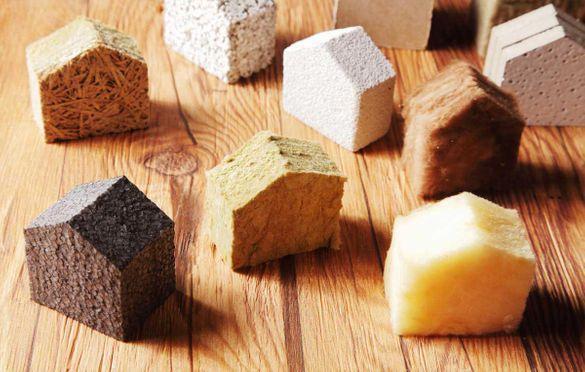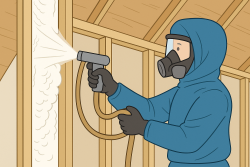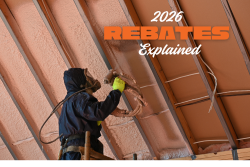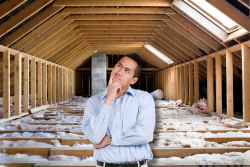When I say home, what do you think of? You probably imagine some part of your house, maybe your bedroom, your living room, or the kitchen. You probably think of how comfortable your house feels and how nice it is to come home after a long day's work.
You probably aren't imagining a cold cement slab, like a prison cell. Yet if your home doesn't have proper insulation, your house will feel more dank and drafty than warm and comfortable. The question then is: how do you choose the best insulation?
All insulation comes with a rating, called an R-value, which measures the heat loss of the material. "The higher the R-value, the better the insulation" is a good rule to follow when getting new insulation.
However, such a rule, while useful, doesn't take into account the full complexity of heat transfer in your home. To get the most insulated home possible, you should know not only an insulation's R-value, but all the other factors that determine how well your home's insulation performs.
WHAT EXACTLY IS AN R-VALUE?
The R-value measures the efficiency of your insulation. The more efficient an insulation material is, the less material you need to slow down the transfer of heat from one side to the other. High efficiency material will generally have a higher R-value.
R-value also increases with the more material you have. However the efficiency doesn't change, so you need less of a high efficient material than of a low efficient one to get better R-values in your home. Your choice of material should depend on how large of an R-value you need and how much material you can afford.
The amount of material you need in your house depends on the area. For example, The R-value of a new attic in Ontario should be 50, while the R-value of your new walls only need to be 29.
However, when you plan to add more or better insulation to your home, the R-value can't be your only guide. The R-value has certain limitations you need to consider as you try to get better insulation.
THE LIMITATIONS OF AN R-VALUE
While the R-value presents a quick and easy way for you to determine the quality of a certain material, the R-value doesn't take into account all of the heat transfer that occurs in your home. The R-value only accounts for how long it takes heat to move through the material. The rating does not take into consideration of how heat moves around the material.
While the method of heat transfer differs, heat always moves from hot places to cold places. So if the inside of your home is cooler than the outdoors, heat will move inside in until temperature equalizes. If your house is warm, heat will try and escape your home into the cold winter air. When your home has a gap in the insulation, heat will inevitably find a way through.
THE PROBLEM OF GAPS IN INSULATION
Gaps in the insulation form from the movement of air and moisture. If you insulation doesn't block air and water infiltration, both will lower the effect of the R-value of your insulation.
For example, large batts of insulation (even those with high R-values) don't create an airtight space around your home. This allows warm air to move around your insulation, or between slabs. Loose insulation also allows air and moisture to flow in between the fibres and create more gaps.
Insulation with gaps don't lose their R-value. The R-values simply explain the efficiency of the material and not the environment around that material. Luckily, if you improve your home's environment and insulation, you can drastically reduce your total heat leakage.
HOW YOU CAN HAVE A WELL INSULATED HOME
The secret to improving your home's insulation depends on three key factors:
- The Type of Insulation
- The Air Flow Around Your Insulation
- The Collection of Moisture Behind Your Insulation
Improve these and you will have an energy efficient home.
BETTER INSULATION
While older types of insulation allow for gaps, new types cut down on them. Spray foam insulation creates a solid seal around your home. The foam expands and fills gaps and corners that other insulation types can't reach.
Blown insulation works well for attic spaces as well. The even coating of insulation stops heat from rising through spaces. Also, both blown and foam insulations retain high R-values, so heat transfer through them stays low.
LESS AIR FLOW
In addition to insulation that seals gaps in your home, you want to seal off the gap between your insulation and the inside of your home to avoid air infiltration. A vapor barrier will catch the air flow missed by your insulation.
LESS MOISTURE
A vapor barrier has the added benefit of preventing moisture from getting caught behind your insulation. Water vapor builds up in your house and can get stuck behind your insolation without a vapor barrier. Not only would this ruin your insulation, it can also cause dry rot to corrode your wood. Vapor barrier seal your inner wall from moisture, keeping your home safe.
TAKE STEPS TO PROPERLY INSULATE YOUR HOME
Now that you know what an R-value is for, you can make an educated decision to better insulate your home. Remember, higher R-values do give you an accurate picture of how efficient your insulation is. However, you need to protect your home's environment by sealing all the gaps and leaks that for in your home. Use our information to find all the ways you can improve your home's insulation.

















